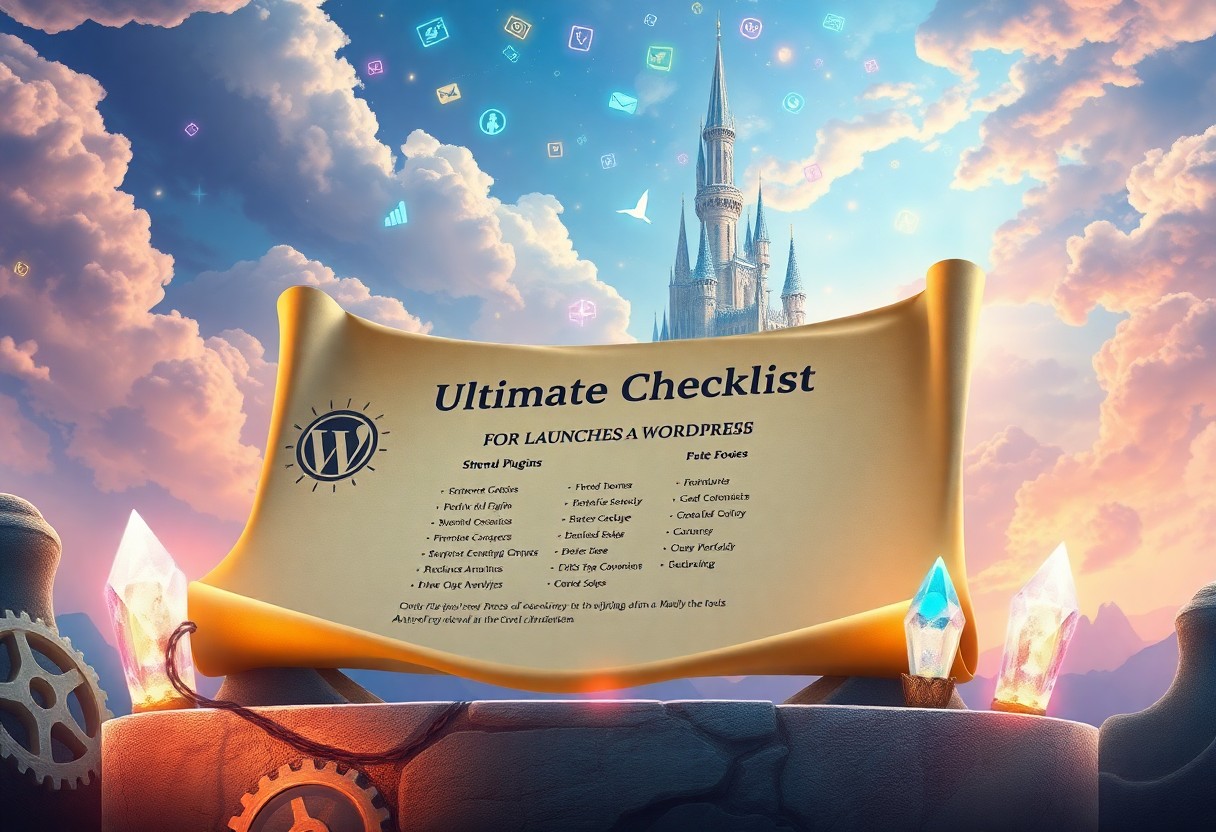With this comprehensive checklist, you will effectively navigate the complexities of launching your WordPress website. From selecting the right hosting provider to optimizing your site for search engines, each step is important for ensuring a smooth launch. Pay close attention to security measures to protect your website from potential threats. By following this guide, you’ll lay a solid foundation for your online presence and pave the way for future growth and success.
Key Takeaways:
- Choose a reliable web host and domain name that reflect your brand.
- Install imperative plugins for SEO, security, and performance optimization.
- Ensure your website design is user-friendly and responsive on all devices.
Choosing the Right Domain Name
Importance of a Good Domain
A well-chosen domain name serves as the foundation for your online identity. It not only contributes to your brand’s credibility but also plays a significant role in search engine optimization. A domain name that reflects your business or niche can significantly enhance your visibility and attract the right audience. Ideally, it should be memorable, concise, and relevant to the content of your site. Studies show that shorter domain names tend to perform better in user retention rates, making them more effective for marketing strategies.
Moreover, a domain name can impact your site’s overall success. Consider the case of tech startups that leverage catchy domain names; they often see increased investor interest due to perceived professionalism. Your domain can set the tone for user expectations; thus, prioritizing a good name can ultimately lead to higher traffic and engagement on your site.
Domain Registration Process
The domain registration process is straightforward but requires careful consideration. Initially, you need to select a domain registrar, ensuring it’s reputable and accredited by the Internet Corporation for Assigned Names and Numbers (ICANN). Once you’ve chosen your registrar, you can search for the availability of your desired domain name. If it’s available, you’ll proceed to register it by providing your contact information and paying the registration fee, which typically ranges from $10 to $50 annually.
After registration, pay attention to your domain management. You’ll need to renew your domain periodically to avoid losing it, which can happen quickly if you forget. Many registrars offer auto-renew options, allowing you to maintain ownership without worry. Also, consider setting up domain privacy protection to safeguard your personal information from public view, as this can prevent spam and unwanted contacts.
Various registrars like GoDaddy, Namecheap, and Google Domains offer easy-to-navigate platforms for these tasks. They often provide tools that help you choose a domain based on keywords or suggest alternatives if your first choice isn’t available. Utilizing these features can significantly streamline your domain selection and registration process.
Selecting a Reliable Hosting Provider
Choosing the right hosting provider is fundamental to the success of your WordPress website. The performance, uptime, and speed of your site largely depend on the type of hosting service you select. There are several options available, each with its unique advantages and disadvantages. It’s vital to evaluate your specific needs before making a decision to ensure that your hosting solution aligns with your website goals.
Types of Hosting Services
Regarding hosting, you will encounter a variety of services including shared hosting, VPS hosting, dedicated hosting, cloud hosting, and managed WordPress hosting. Each type offers different levels of performance and resources:
| Shared Hosting | Cost-effective, but resources are shared between multiple websites. |
| VPS Hosting | Offers more control and dedicated resources in a virtual environment. |
| Dedicated Hosting | Provides an entire server for your website, offering maximum performance. |
| Cloud Hosting | Scalable resources hosted across multiple servers to handle traffic spikes. |
| Managed WordPress Hosting | Specifically optimized for WordPress, often includes enhanced security and backups. |
Consider evaluating the type of hosting service based on your website’s expected traffic, performance requirements, and budget constraints. It’s vital to weigh the features and pricing as you determine the best fit for your project.
Factors to Consider
There are key factors that should influence your decision when selecting a hosting provider. These include uptime guarantee, customer support, scalability options, security features, and loading speed. Assessing these elements can significantly impact your website’s overall performance and reliability.
- Uptime Guarantee
- Customer Support
- Scalability Options
- Security Features
- Loading Speed
Your selected hosting provider should have a proven track record of consistently high uptime, ideally above 99.9%. Adaptable customer support, ideally available 24/7, ensures help is at hand whenever an issue arises. When traffic increases, your hosting needs may evolve; thus, scalability options are paramount. Essential security features protect your site against potential threats, while loading speed directly influences user experience.
- Performance Optimization
- Backup Solutions
- Easy-to-use Control Panel
- Multiple Data Center Locations
- Pricing Plans
As you navigate your options, consider how performance optimization tools and backup solutions can enhance your website. An intuitive control panel makes management simpler, while multiple data center locations could minimize latency. Ultimately, a range of pricing plans will help you find the most suitable option fitting within your budget. Thou must choose wisely, as these factors will ultimately shape your website’s success.
Installing WordPress
One-Click Install vs. Manual Installation
In the context of installing WordPress, you have two primary options: one-click installation and manual installation. The one-click installation is the preferred choice for most users, especially beginners. This method allows you to set up WordPress in just a few clicks, typically through your hosting provider’s control panel. Providers like Bluehost, SiteGround, and WP Engine offer this feature, simplifying the process and significantly reducing the technical barriers involved.
On the other hand, manual installation gives you more control over the setup process and is imperative for advanced users who want to customize their installation. It involves downloading the WordPress software, uploading it to your server via FTP, and creating a database. This method requires a basic understanding of web hosting and databases, but it can be beneficial for those who wish to tailor their installation to specific needs.
Configuring Basic Settings
Once WordPress is installed, configuring basic settings is the next step to ensure your site runs optimally. Start by navigating to the Settings menu in your WordPress dashboard. Here, you can set up your site title, tagline, and URL structure. These elements will significantly impact your site’s visibility and branding, so choose them wisely. Adjust the time zone, date format, and other preferences to align with your audience’s location and your content schedule.
In addition to general settings, pay close attention to the permalinks settings. Opt for a structure that improves SEO, such as the “Post name” option. This format not only makes URLs more user-friendly but also enhances search engine discoverability. Consider activating your site’s visibility settings after initial configuration, as keeping it indexed during this phase can benefit your site’s ranking as content builds over time.
It’s also wise to explore additional configuration options such as enabling or disabling comments and setting up the default user roles for new users. These settings can shape how interactive your site is and define user permissions early in the setup process. A streamlined configuration promotes a better experience for both you and your visitors.
Choosing and Customizing a Theme
Free vs. Premium Themes
When identifying a theme for your WordPress website, you face the choice between free and premium options. Free themes are available within the WordPress theme repository and can be an excellent starting point, especially if you’re on a tight budget. However, they often come with limitations regarding features, customization, and support. In contrast, premium themes typically offer more advanced functionalities, superior design quality, and reliable customer support. Investing in a premium theme can enhance user experience and save time during the customization process.
Keep in mind that while premium themes often range from $30 to $100, they can provide tools such as drag-and-drop editors, built-in SEO optimizations, and extensive color and layout options that free themes may lack. Evaluate your needs as you make this choice; sometimes, the benefits of a premium theme can outweigh the initial investment if it leads to better engagement and conversions.
Essential Theme Customizations
Customizing your theme is vital to ensure it aligns with your brand identity and enhances usability. Start by modifying the header and footer to reflect your business name and logo prominently. Adjusting the color palette and typography can create a cohesive design that resonates with your audience. Utilize the customization options to manage layouts, sidebars, and widgets effectively, tailoring them to highlight key content or features.
Another vital customization involves configuring your menu structure. A well-organized menu not only improves navigation but also guides visitors to important sections of your site. Consider incorporating social media icons and contact information in your footer for easier access. Integrating these elements can significantly improve user experience and encourage engagement.
Moreover, leveraging plugins alongside your theme can expand functionality. For instance, using a page builder plugin allows for a more personalized layout without any coding experience. Elements such as sliders, galleries, and testimonials can enhance visual appeal, making your site engaging. When customizing, ensure that the adjustments reflect your unique voice and cater to your target audience, creating a compelling platform that feels distinctly yours.

Essential Plugins for Functionality
Must-Have Plugins
After setting up your theme, the next step is to enhance your website’s functionality with plugins. Some of the must-have plugins for any WordPress site include Yoast SEO for optimizing your content, WP Super Cache for improving site speed through caching, and Wordfence Security for safeguarding against malicious attacks. These plugins address key areas of performance—SEO, speed, and security—and they can significantly impact your site’s effectiveness and user experience.
Other plugins worth considering are WooCommerce for e-commerce capabilities, Contact Form 7 for easy communication, and UpdraftPlus for backup solutions. Each of these plugins allows you to tailor your website to your specific needs while ensuring you maintain control over critical functionalities. With over 58,000 plugins available in the WordPress repository, selecting the right tools will depend on your site’s objectives and audience.
Installing and Configuring Plugins
To install plugins, navigate to the Plugins section in your WordPress dashboard and select ‘Add New.’ Here, you can search for specific plugins by name, or browse by categories and tags. Once you find a plugin that meets your requirements, click ‘Install Now’ and then activate it. Each plugin typically comes with its own settings menu where you can configure it to fit your needs. For instance, Yoast SEO provides comprehensive options for on-page SEO, while WooCommerce requires settings for your products and payment gateways.
Configuring your plugins is just as important as installing them. Every site is unique, and customizing your plugins can vastly improve their functionality. For example, with caching plugins, it’s crucial to understand how to set up cache expiration times and exclusions for dynamic content. Additionally, learning how to enable automatic updates on security plugins will help you maintain a safer website with minimal effort on your part.
Effective plugin management involves not just installation but also regular updates and reviews to ensure compatibility with the latest WordPress version. Keeping your plugins updated prevents potential security vulnerabilities and ensures optimal performance. Additionally, periodically assessing the necessity of each plugin can help you streamline site speed and functionality, as some plugins may overlap in features, slowing down your site unnecessarily.

Creating Content for Your Website
Types of Content to Include
With respect to developing content for your website, it’s imperative to consider various types of content that resonate with your target audience. Start with blog posts that address common questions or concerns in your niche—this not only establishes your authority but also drives organic traffic. Incorporate videos to engage users visually, and consider integrating infographics for quick information sharing. Moreover, case studies and testimonials build trust by showcasing the effectiveness of your products or services.
| Content Type | Description |
| Blog Posts | Informative articles targeting your audience’s needs. |
| Videos | Dynamic content that boosts engagement and sharing. |
| Infographics | Visually appealing way to present data and insights. |
| Case Studies | In-depth analysis demonstrating success stories. |
| Testimonials | User feedback that reinforces your credibility. |
Thou should also engage with SEO best practices by optimizing your content for search engines. Utilizing keywords strategically will enhance your visibility and increase traffic significantly. Tailored content for your audience not only supports user experience but also fosters loyalty.
Best Practices for Content Creation
To maximize the impact of your content, adhere to specific best practices that ensure quality and relevance. Always conduct thorough research to understand what resonates with your audience. Employ a consistent tone and style across all content to create a cohesive brand identity. Keep your content organized and easy to read by using headings, bullet points, and short paragraphs. This enhances readability and allows readers to skim through the key points quickly. Moreover, update your content regularly to ensure accuracy and maintain user interest.
Investing time in your content strategy pays off; analytics show that websites with a diverse and regularly updated content portfolio tend to experience higher engagement rates. Creating content that aligns with your audience’s needs will cultivate a community around your brand, ultimately driving conversions and fostering long-term relationships. Thus, focus on quality over quantity, as your audience craves genuine value over a mere influx of information.
Final Words
On the whole, launching a WordPress website requires careful planning and execution to ensure that your site stands out and functions effectively. By following the ultimate checklist, you equip yourself with a comprehensive framework that covers everything from selecting the right hosting provider to optimizing your content for search engines. Each step in this checklist plays a significant role in shaping your website’s performance and user experience.
As you proceed with each item on the checklist, stay focused on your website’s goals, whether that’s increasing traffic, enhancing engagement, or driving conversions. Your attention to detail at every stage not only enhances the functionality of your site but also positions you to achieve long-term success. By approaching your website launch with a methodical mindset, you’ll be well-prepared to create a robust online presence that effectively meets the needs of your audience.
FAQ
Q: What are the crucial steps to take before launching my WordPress website?
A: Before launching your WordPress website, ensure you have completed the following steps:
1. Choose a domain name that reflects your brand.
2. Select a reliable hosting provider to host your site.
3. Install WordPress and configure your settings.
4. Choose and customize a theme that aligns with your brand identity.
5. Install necessary plugins for functionality, such as SEO and security.
6. Create crucial pages, including Home, About, Contact, and Privacy Policy.
7. Test the website on multiple devices and browsers for compatibility.
Q: How do I optimize my WordPress website for SEO before launch?
A: To optimize your WordPress website for SEO, follow these guidelines:
1. Install an SEO plugin like Yoast SEO to assist with optimization tasks.
2. Use relevant keywords in your page titles, headings, and content.
3. Create quality content that provides value to your audience.
4. Optimize images with descriptive alt tags and appropriate file sizes.
5. Configure permalink structure for improved URL readability.
6. Submit your sitemap to search engines using Google Search Console.
Q: What security measures should I implement before launching my WordPress site?
A: To enhance security for your WordPress site before launch, consider these measures:
1. Use strong passwords for all user accounts, especially the admin account.
2. Limit login attempts to prevent brute force attacks.
3. Install a security plugin, such as Wordfence or Sucuri, for added protection.
4. Regularly update WordPress core, themes, and plugins to their latest versions.
5. Enable SSL to secure data transmission between users and your site.
6. Perform regular backups to safeguard your content and data.
